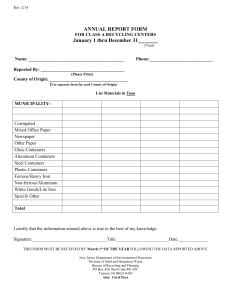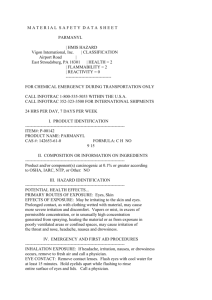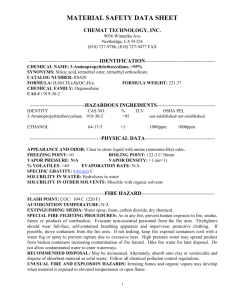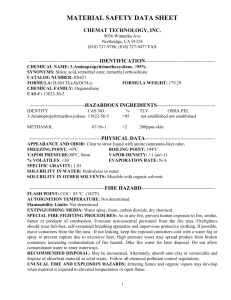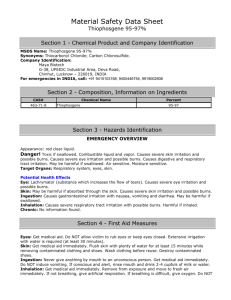1,1,1,3,3,3-Hexafluoro-2-propanol MSDS | Safety Data
advertisement
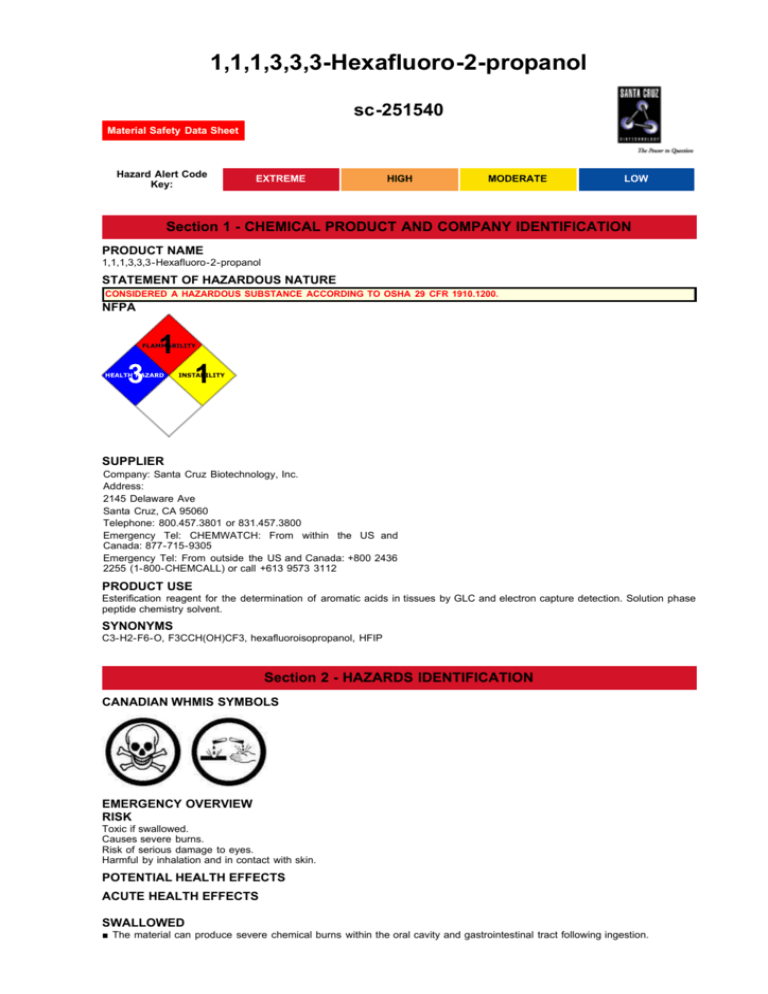
1,1,1,3,3,3-Hexafluoro-2-propanol sc-251540 Material Safety Data Sheet Hazard Alert Code Key: EXTREME HIGH MODERATE LOW Section 1 - CHEMICAL PRODUCT AND COMPANY IDENTIFICATION PRODUCT NAME 1,1,1,3,3,3-Hexafluoro-2-propanol STATEMENT OF HAZARDOUS NATURE CONSIDERED A HAZARDOUS SUBSTANCE ACCORDING TO OSHA 29 CFR 1910.1200. NFPA 1 FLAMMABILITY 3 HEALTH HAZARD 1 INSTABILITY SUPPLIER Company: Santa Cruz Biotechnology, Inc. Address: 2145 Delaware Ave Santa Cruz, CA 95060 Telephone: 800.457.3801 or 831.457.3800 Emergency Tel: CHEMWATCH: From within the US and Canada: 877-715-9305 Emergency Tel: From outside the US and Canada: +800 2436 2255 (1-800-CHEMCALL) or call +613 9573 3112 PRODUCT USE Esterification reagent for the determination of aromatic acids in tissues by GLC and electron capture detection. Solution phase peptide chemistry solvent. SYNONYMS C3-H2-F6-O, F3CCH(OH)CF3, hexafluoroisopropanol, HFIP Section 2 - HAZARDS IDENTIFICATION CANADIAN WHMIS SYMBOLS EMERGENCY OVERVIEW RISK Toxic if swallowed. Causes severe burns. Risk of serious damage to eyes. Harmful by inhalation and in contact with skin. POTENTIAL HEALTH EFFECTS ACUTE HEALTH EFFECTS SWALLOWED ■ The material can produce severe chemical burns within the oral cavity and gastrointestinal tract following ingestion. ■ Toxic effects may result from the accidental ingestion of the material; animal experiments indicate that ingestion of less than 40 gram may be fatal or may produce serious damage to the health of the individual. ■ Ingestion of acidic corrosives may produce burns around and in the mouth. the throat and esophagus. Immediate pain and difficulties in swallowing and speaking may also be evident. Swelling of the epiglottis may make it difficult to breathe which may result in suffocation. More severe exposure may result in vomiting blood and thick mucus, shock, abnormally low blood pressure, fluctuating pulse, shallow respiration and clammy skin, inflammation of stomach wall, and rupture of esophageal tissue. Untreated shock may eventually result in kidney failure. Severe cases may result in perforation of the stomach and abdominal cavity with consequent infection, rigidity and fever. There may be severe narrowing of the esophageal or pyloric sphincters; this may occur immediately or after a delay of weeks to years. There may be coma and convulsions, followed by death due to infection of the abdominal cavity, kidneys or lungs. EYE ■ The material can produce severe chemical burns to the eye following direct contact. Vapors or mists may be extremely irritating. ■ If applied to the eyes, this material causes severe eye damage. ■ Direct eye contact with acid corrosives may produce pain, tears, sensitivity to light and burns. Mild burns of the epithelia generally recover rapidly and completely. Severe burns produce long-lasting and possibly irreversible damage. The appearance of the burn may not be apparent for several weeks after the initial contact. The cornea may ultimately become deeply opaque resulting in blindness. SKIN ■ The material can produce severe chemical burns following direct contactwith the skin. ■ Skin contact with the material may be harmful; systemic effects may resultfollowing absorption. ■ Skin contact with acidic corrosives may result in pain and burns; these may be deep with distinct edges and may heal slowly with the formation of scar tissue. ■ Open cuts, abraded or irritated skin should not be exposed to this material. ■ Entry into the blood-stream, through, for example, cuts, abrasions or lesions, may produce systemic injury with harmful effects. Examine the skin prior to the use of the material and ensure that any external damage is suitably protected. INHALED ■ Inhalation of vapors or aerosols (mists, fumes), generated by the material during the course of normal handling, may be harmful. ■ The material can cause respiratory irritation in some persons. The body's response to such irritation can cause further lung damage. ■ Corrosive acids can cause irritation of the respiratory tract, with coughing, choking and mucous membrane damage. There may be dizziness, headache, nausea and weakness. Swelling of the lungs can occur, either immediately or after a delay; symptoms of this include chest tightness, shortness of breath, frothy phlegm and cyanosis. Lack of oxygen can cause death hours after onset. ■ Inhalation of quantities of liquid mist may be extremely hazardous, even lethal due to spasm, extreme irritation of larynx and bronchi, chemical pneumonitis and pulmonary edema. ■ Material is highly volatile and may quickly form a concentrated atmosphere in confined or unventilated areas. Vapor is heavier than air and may displace and replace air in breathing zone, acting as a simple asphyxiant. This may happen with little warning of overexposure. CHRONIC HEALTH EFFECTS ■ Long-term exposure to respiratory irritants may result in disease of the airways involving difficult breathing and related systemic problems. Repeated or prolonged exposure to acids may result in the erosion of teeth, swelling and or ulceration of mouth lining. Irritation of airways to lung, with cough, and inflammation of lung tissue often occurs. Chronic exposure may inflame the skin or conjunctiva. Limited evidence suggests that repeated or long-term occupational exposure may produce cumulative health effects involving organs or biochemical systems. Section 3 - COMPOSITION / INFORMATION ON INGREDIENTS HAZARD RATINGS Min Flammability: 1 Toxicity: 3 Body Contact: 4 Reactivity: 1 Chronic: 2 Max Min/Nil=0 Low=1 Moderate=2 High=3 Extreme=4 NAME CAS RN % 1,1,1,3,3,3-hexafluoro-2-propanol 920-66-1 >98 Section 4 - FIRST AID MEASURES SWALLOWED ■ For advice, contact a Poisons Information Center or a doctor at once. Urgent hospital treatment is likely to be needed. If swallowed do NOT induce vomiting. If vomiting occurs, lean patient forward or place on left side (head-down position, if possible) to maintain open airway and prevent aspiration. Observe the patient carefully. Never give liquid to a person showing signs of being sleepy or with reduced awareness; i.e. becoming unconscious. Give water to rinse out mouth, then provide liquid slowly and as much as casualty can comfortably drink. Transport to hospital or doctor without delay. EYE ■ If this product comes in contact with the eyes: Immediately hold eyelids apart and flush the eye continuously with running water. Ensure complete irrigation of the eye by keeping eyelids apart and away from eye and moving the eyelids by occasionally lifting the upper and lower lids. Continue flushing until advised to stop by the Poisons Information Center or a doctor, or for at least 15 minutes. Transport to hospital or doctor without delay. Removal of contact lenses after an eye injury should only be undertaken by skilled personnel. SKIN ■ If skin or hair contact occurs: Immediately flush body and clothes with large amounts of water, using safety shower if available. Quickly remove all contaminated clothing, including footwear. Wash skin and hair with running water. Continue flushing with water until advised to stop by the Poisons Information Center. Transport to hospital, or doctor. INHALED ■ If fumes or combustion products are inhaled remove from contaminated area. Lay patient down. Keep warm and rested. Prostheses such as false teeth, which may block airway, should be removed, where possible, prior to initiating first aid procedures. Apply artificial respiration if not breathing, preferably with a demand valve resuscitator, bag-valve mask device, or pocket mask as trained. Perform CPR if necessary. Transport to hospital, or doctor, without delay. Inhalation of vapors or aerosols (mists, fumes) may cause lung edema. Corrosive substances may cause lung damage (e.g. lung edema, fluid in the lungs). As this reaction may be delayed up to 24 hours after exposure, affected individuals need complete rest (preferably in semi-recumbent posture) and must be kept under medical observation even if no symptoms are (yet) manifested. Before any such manifestation, the administration of a spray containing a dexamethasone derivative or beclomethasone derivative may be considered. This must definitely be left to a doctor or person authorized by him/her. (ICSC13719). NOTES TO PHYSICIAN ■ Treat symptomatically. For acute or short term repeated exposures to strong acids: Airway problems may arise from laryngeal edema and inhalation exposure. Treat with 100% oxygen initially. Respiratory distress may require cricothyroidotomy if endotracheal intubation is contraindicated by excessive swelling Intravenous lines should be established immediately in all cases where there is evidence of circulatory compromise. Strong acids produce a coagulation necrosis characterized by formation of a coagulum (eschar) as a result of the dessicating action of the acid on proteins in specific tissues. INGESTION: Immediate dilution (milk or water) within 30 minutes post ingestion is recommended. DO NOT attempt to neutralize the acid since exothermic reaction may extend the corrosive injury. Be careful to avoid further vomit since re-exposure of the mucosa to the acid is harmful. Limit fluids to one or two glasses in an adult. Charcoal has no place in acid management. Some authors suggest the use of lavage within 1 hour of ingestion. SKIN: Skin lesions require copious saline irrigation. Treat chemical burns as thermal burns with non-adherent gauze and wrapping. Deep second-degree burns may benefit from topical silver sulfadiazine. EYE: Eye injuries require retraction of the eyelids to ensure thorough irrigation of the conjuctival cul-de-sacs. Irrigation should last at least 20-30 minutes. DO NOT use neutralizing agents or any other additives. Several liters of saline are required. Cycloplegic drops, (1% cyclopentolate for short-term use or 5% homatropine for longer term use) antibiotic drops, vasoconstrictive agents or artificial tears may be indicated dependent on the severity of the injury. Steroid eye drops should only be administered with the approval of a consulting ophthalmologist). [Ellenhorn and Barceloux: Medical Toxicology]. Section 5 - FIRE FIGHTING MEASURES Vapour Pressure (mmHG): Not available Upper Explosive Limit (%): Not available Specific Gravity (water=1): 1.596 Lower Explosive Limit (%): Not available EXTINGUISHING MEDIA ■ Foam. Dry chemical powder. BCF (where regulations permit). Carbon dioxide. Water spray or fog - Large fires only. FIRE FIGHTING ■ Alert Emergency Responders and tell them location and nature of hazard. Wear full body protective clothing with breathing apparatus. Prevent, by any means available, spillage from entering drains or water course. Use fire fighting procedures suitable for surrounding area. DO NOT approach containers suspected to be hot. Cool fire exposed containers with water spray from a protected location. If safe to do so, remove containers from path of fire. Equipment should be thoroughly decontaminated after use. GENERAL FIRE HAZARDS/HAZARDOUS COMBUSTIBLE PRODUCTS ■ Combustible. Slight fire hazard when exposed to heat or flame. Acids may react with metals to produce hydrogen, a highly flammable and explosive gas. Heating may cause expansion or decomposition leading to violent rupture of rigid containers. May emit acrid smoke and corrosive fumes. Combustion products include: carbon monoxide (CO), carbon dioxide (CO2), hydrogen fluoride, other pyrolysis products typical of burning organic material. Contains low boiling substance: Closed containers may rupture due to pressure buildup under fire conditions. FIRE INCOMPATIBILITY ■ Avoid contamination with oxidizing agents i.e. nitrates, oxidizing acids,chlorine bleaches, pool chlorine etc. as ignition may result. PERSONAL PROTECTION Glasses: Safety Glasses. Full face- shield. Gloves: Respirator: Type AX Filter of sufficient capacity Section 6 - ACCIDENTAL RELEASE MEASURES MINOR SPILLS ■ Drains for storage or use areas should have retention basins for pH adjustments and dilution of spills before discharge or disposal of material. Check regularly for spills and leaks. Clean up all spills immediately. Avoid breathing vapors and contact with skin and eyes. Control personal contact by using protective equipment. Contain and absorb spill with sand, earth, inert material or vermiculite. Wipe up. Place in a suitable labeled container for waste disposal. MAJOR SPILLS ■ Chemical Class:acidic compounds, organic For release onto land: recommended sorbents listed in order of priority. SORBENT TYPE RANK APPLICATION COLLECTION LIMITATIONS LAND SPILL - SMALL wood fiber - pillow 1 throw pitchfork R, P, DGC, RT cross-linked polymer 1 shovel shovel R,W,SS particulate cross-linked polymer 1 throw pitchfork R, DGC, RT pillow sorbent clay - particulate 2 shovel shovel R, I, P foamed glass - pillow 2 throw pitchfork R, P, DGC, RT wood fiber - particulate 3 shovel shovel R, W, P, DGC LAND SPILL - MEDIUM cross-linked polymer 1 blower skiploader R, W, SS particulate polypropylene 2 blower skiploader W, SS, DGC particulate sorbent clay - particulate 2 blower skiploader R, I, P cross-linked polymer 3 throw skiploader R, DGC, RT pillow polypropylene - mat 3 throw skiploader W, SS, DGC expanded mineral 3 blower skiploader R, I, W, P, DGC particulate Legend DGC: Not effective where ground cover is dense R; Not reusable I: Not incinerable P: Effectiveness reduced when rainy RT:Not effective where terrain is rugged SS: Not for use within environmentally sensitive sites W: Effectiveness reduced when windy Reference: Sorbents for Liquid Hazardous Substance Cleanup and Control; R.W Melvold et al: Pollution Technology Review No. 150: Noyes Data Corporation 1988. Clear area of personnel and move upwind. Alert Emergency Responders and tell them location and nature of hazard. May be violently or explosively reactive. Wear full body protective clothing with breathing apparatus. Prevent, by any means available, spillage from entering drains or water course. Consider evacuation (or protect in place). Stop leak if safe to do so. Contain spill with sand, earth or vermiculite. Collect recoverable product into labeled containers for recycling. Neutralize/decontaminate residue. Collect solid residues and seal in labeled drums for disposal. Wash area and prevent runoff into drains. After clean up operations, decontaminate and launder all protective clothing and equipment before storing and re-using. If contamination of drains or waterways occurs, advise emergency services. PROTECTIVE ACTIONS FOR SPILL From IERG (Canada/Australia) Isolation Distance 25 meters Downwind Protection 250 Distance meters FOOTNOTES 1 PROTECTIVE ACTION ZONE is defined as the area in which people are at risk of harmful exposure. This zone assumes that random changes in wind direction confines the vapour plume to an area within 30 degrees on either side of the predominant wind direction, resulting in a crosswind protective action distance equal to the downwind protective action distance. 2 PROTECTIVE ACTIONS should be initiated to the extent possible, beginning with those closest to the spill and working away from the site in the downwind direction. Within the protective action zone a level of vapour concentration may exist resulting in nearly all unprotected persons becoming incapacitated and unable to take protective action and/or incurring serious or irreversible health effects. 3 INITIAL ISOLATION ZONE is determined as an area, including upwind of the incident, within which a high probability of localised wind reversal may expose nearly all persons without appropriate protection to life-threatening concentrations of the material. 4 SMALL SPILLS involve a leaking package of 200 litres (55 US gallons) or less, such as a drum (jerrican or box with inner containers). Larger packages leaking less than 200 litres and compressed gas leaking from a small cylinder are also considered "small spills". LARGE SPILLS involve many small leaking packages or a leaking package of greater than 200 litres, such as a cargo tank, portable tank or a "one -tonne" compressed gas cylinder. 5 Guide 154 is taken from the US DOT emergency response guide book. 6 IERG information is derived from CANUTEC - Transport Canada. ACUTE EXPOSURE GUIDELINE LEVELS (AEGL) (in ppm) AEGL 1: The airborne concentration of a substance above which it is predicted that the general population, including susceptible individuals, could experience notable discomfort, irritation, or certain asymptomatic nonsensory effects. However, the effects are not disabling and are transient and reversible upon cessation of exposure. AEGL 2: The airborne concentration of a substance above which it is predicted that the general population, including susceptible individuals, could experience irreversible or other serious, long-lasting adverse health effects or an impaired ability to escape. AEGL 3: The airborne concentration of a substance above which it is predicted that the general population, including susceptible individuals, could experience life-threatening health effects or death. Section 7 - HANDLING AND STORAGE PROCEDURE FOR HANDLING ■ Contains low boiling substance: Storage in sealed containers may result in pressure buildup causing violent rupture of containers not rated appropriately. Check for bulging containers. Vent periodically Always release caps or seals slowly to ensure slow dissipation of vapors DO NOT allow clothing wet with material to stay in contact with skin Avoid all personal contact, including inhalation. Wear protective clothing when risk of exposure occurs. Use in a well-ventilated area. WARNING: To avoid violent reaction, ALWAYS add material to water and NEVER water to material. Avoid smoking, naked lights or ignition sources. Avoid contact with incompatible materials. When handling, DO NOT eat, drink or smoke. Keep containers securely sealed when not in use. Avoid physical damage to containers. Always wash hands with soap and water after handling. Work clothes should be laundered separately. Launder contaminated clothing before re-use. Use good occupational work practice. Observe manufacturer's storing and handling recommendations. Atmosphere should be regularly checked against established exposure standards to ensure safe working conditions are maintained. RECOMMENDED STORAGE METHODS ■ DO NOT use aluminum or galvanized containers. Check regularly for spills and leaks. Glass container. Lined metal can, Lined metal pail/drum Plastic pail Polyliner drum Packing as recommended by manufacturer. Check all containers are clearly labeled and free from leaks. For low viscosity materials Drums and jerricans must be of the non-removable head type. Where a can is to be used as an inner package, the can must have a screwed enclosure. For materials with a viscosity of at least 2680 cSt. (23 deg. C) and solids (between 15 C deg. and 40 deg C.): Removable head packaging; Cans with friction closures and low pressure tubes and cartridges may be used. - Where combination packages are used, and the inner packages are of glass, porcelain or stoneware, there must be sufficient inert cushioning material in contact with inner and outer packages unless the outer packaging is a close fitting molded plastic box and the substances are not incompatible with the plastic. STORAGE REQUIREMENTS ■ Store in original containers. Keep containers securely sealed. Store in a cool, dry, well-ventilated area. Store away from incompatible materials and foodstuff containers. Protect containers against physical damage and check regularly for leaks. Observe manufacturer's storing and handling recommendations. SAFE STORAGE WITH OTHER CLASSIFIED CHEMICALS X X + X X + X: Must not be stored together O: May be stored together with specific preventions +: May be stored together Section 8 - EXPOSURE CONTROLS / PERSONAL PROTECTION EXPOSURE CONTROLS The following materials had no OELs on our records • 1,1,1,3,3,3-hexafluoro-2-propanol: CAS:920-66-1 MATERIAL DATA 1,1,1,3,3,3-HEXAFLUORO-2-PROPANOL: ■ Sensory irritants are chemicals that produce temporary and undesirable side-effects on the eyes, nose or throat. Historically occupational exposure standards for these irritants have been based on observation of workers' responses to various airborne concentrations. Present day expectations require that nearly every individual should be protected against even minor sensory irritation and exposure standards are established using uncertainty factors or safety factors of 5 to 10 or more. On occasion animal no-observable-effect-levels (NOEL) are used to determine these limits where human results are unavailable. An additional approach, typically used by the TLV committee (USA) in determining respiratory standards for this group of chemicals, has been to assign ceiling values (TLV C) to rapidly acting irritants and to assign short-term exposure limits (TLV STELs) when the weight of evidence from irritation, bioaccumulation and other endpoints combine to warrant such a limit. In contrast the MAK Commission (Germany) uses a five-category system based on intensive odour, local irritation, and elimination half-life. However this system is being replaced to be consistent with the European Union (EU) Scientific Committee for Occupational Exposure Limits (SCOEL); this is more closely allied to that of the USA. OSHA (USA) concluded that exposure to sensory irritants can: cause inflammation cause increased susceptibility to other irritants and infectious agents lead to permanent injury or dysfunction permit greater absorption of hazardous substances and acclimate the worker to the irritant warning properties of these substances thus increasing the risk of overexposure. PERSONAL PROTECTION Consult your EHS staff for recommendations EYE ■ Chemical goggles. Full face shield. Contact lenses pose a special hazard; soft contact lenses may absorb irritants and all lenses concentrate them. HANDS/FEET ■ Elbow length PVC gloves. When handling corrosive liquids, wear trousers or overalls outside of boots, to avoid spills entering boots. Suitability and durability of glove type is dependent on usage. Important factors in the selection of gloves include: such as: frequency and duration of contact, chemical resistance of glove material, glove thickness and dexterity Select gloves tested to a relevant standard (e.g. Europe EN 374, US F739). When prolonged or frequently repeated contact may occur, a glove with a protection class of 5 or higher (breakthrough time greater than 240 minutes according to EN 374) is recommended. When only brief contact is expected, a glove with a protection class of 3 or higher (breakthrough time greater than 60 minutes according to EN 374) is recommended. Contaminated gloves should be replaced. Gloves must only be worn on clean hands. After using gloves, hands should be washed and dried thoroughly. Application of a non-perfumed moisturiser is recommended. OTHER ■ Overalls. PVC Apron. PVC protective suit may be required if exposure severe. Eyewash unit. Ensure there is ready access to a safety shower. RESPIRATOR ■ Selection of the Class and Type of respirator will depend upon the level of breathing zone contaminant and the chemical nature of the contaminant. Protection Factors (defined as the ratio of contaminant outside and inside the mask) may also be important. Breathing Zone Level ppm Maximum Protection Factor Half-face Respirator Full-Face Respirator (volume) 1000 10 AX-1 1000 50 AX-1 5000 50 Airline* 5000 100 AX-2 10000 100 AX-3 100+ Airline* * * - Continuous Flow ** - Continuous-flow or positive pressure demand. The local concentration of material, quantity and conditions of use determine the type of personal protective equipment required. Use appropriate NIOSH-certified respirator based on informed professional judgement. In conditions where no reasonable estimate of exposure can be made, assume the exposure is in a concentration IDLH and use NIOSH-certified full face pressure demand SCBA with a minimum service life of 30 minutes, or a combination full facepiece pressure demand SAR with auxiliary self-contained air supply. Respirators provided only for escape from IDLH atmospheres shall be NIOSH-certified for escape from the atmosphere in which they will be used. ENGINEERING CONTROLS ■ Local exhaust ventilation usually required. If risk of overexposure exists, wear an approved respirator. Correct fit is essential to obtain adequate protection an approved self contained breathing apparatus (SCBA) may be required in some situations. Provide adequate ventilation in warehouse or closed storage area. Air contaminants generated in the workplace possess varying "escape" velocities which, in turn, determine the "capture velocities" of fresh circulating air required to effectively remove the contaminant. Type of Contaminant: Air Speed: solvent, vapors, degreasing etc., evaporating from tank (in still 0.25-0.5 m/s (50-100 f/min.) air). aerosols, fumes from pouring operations, intermittent container filling, low speed conveyer transfers, welding, spray 0.5-1 m/s (100-200 f/min.) drift, plating acid fumes, pickling (released at low velocity into zone of active generation) direct spray, spray painting in shallow booths, drum filling, conveyer loading, crusher dusts, gas discharge (active generation into zone of rapid air motion) 1-2.5 m/s (200-500 f/min.) grinding, abrasive blasting, tumbling, high speed wheel generated dusts (released at high initial velocity into zone of very high rapid air motion). 2.5-10 m/s (500-2000 f/min.) Within each range the appropriate value depends on: Lower end of the range Upper end of the range 1: Room air currents minimal or favorable to capture 1: Disturbing room air currents 2: Contaminants of low toxicity or of nuisance value only. 2: Contaminants of high toxicity 3: Intermittent, low production. 3: High production, heavy use 4: Large hood or large air mass in motion 4: Small hood-local control only Simple theory shows that air velocity falls rapidly with distance away from the opening of a simple extraction pipe. Velocity generally decreases with the square of distance from the extraction point (in simple cases). Therefore the air speed at the extraction point should be adjusted, accordingly, after reference to distance from the contaminating source. The air velocity at the extraction fan, for example, should be a minimum of 1-2 m/s (200-400 f/min) for extraction of solvents generated in a tank 2 meters distant from the extraction point. Other mechanical considerations, producing performance deficits within the extraction apparatus, make it essential that theoretical air velocities are multiplied by factors of 10 or more when extraction systems are installed or used. Section 9 - PHYSICAL AND CHEMICAL PROPERTIES PHYSICAL PROPERTIES Does not mix with water. Sinks in water. Corrosive. Acid. State LIQUID Molecular Weight 168.04 Melting Range (°F) 24.8 Viscosity Not Available Boiling Range (°F) 138.2 Solubility in water (g/L) Partly miscible Flash Point (°F) Not Available pH (1% solution) Not available Decomposition Temp (°F) Not Available pH (as supplied) Not applicable Autoignition Temp (°F) Not available Vapour Pressure (mmHG) Not available Upper Explosive Limit (%) Not available Specific Gravity (water=1) 1.596 Lower Explosive Limit (%) Not available Relative Vapor Density (air=1) Not available. Volatile Component (%vol) Not available Evaporation Rate Not available APPEARANCE Colourless liquid; does not mix well with water. Section 10 - CHEMICAL STABILITY CONDITIONS CONTRIBUTING TO INSTABILITY ■ Contact with alkaline material liberates heat Presence of incompatible materials. Product is considered stable. Hazardous polymerization will not occur. STORAGE INCOMPATIBILITY ■ Segregate from alkalis, oxidizing agents and chemicals readily decomposed by acids, i.e. cyanides, sulfides, carbonates. Reacts with mild steel, galvanized steel / zinc producing hydrogen gas which may form an explosive mixture with air. Avoid strong acids, bases. For incompatible materials - refer to Section 7 - Handling and Storage. Section 11 - TOXICOLOGICAL INFORMATION 1,1,1,3,3,3-hexafluoro-2-propanol TOXICITY AND IRRITATION ■ unless otherwise specified data extracted from RTECS - Register of Toxic Effects of Chemical Substances. TOXICITY IRRITATION Oral (rat) LD50: 1040 mg/kg * Nil Reported Inhalation (rat) LC50: 1950 ppm * * [Sigma/ Aldrich] Oral (mouse) LD50: 600 mg/kg Intraperitoneal (mouse) LD50: 300 mg/kg Intravenous (mouse) LD50: 180 mg/kg ■ Asthma-like symptoms may continue for months or even years after exposure to the material ceases. This may be due to a non-allergenic condition known as reactive airways dysfunction syndrome (RADS) which can occur following exposure to high levels of highly irritating compound. Key criteria for the diagnosis of RADS include the absence of preceding respiratory disease, in a non-atopic individual, with abrupt onset of persistent asthma-like symptoms within minutes to hours of a documented exposure to the irritant. A reversible airflow pattern, on spirometry, with the presence of moderate to severe bronchial hyperreactivity on methacholine challenge testing and the lack of minimal lymphocytic inflammation, without eosinophilia, have also been included in the criteria for diagnosis of RADS. RADS (or asthma) following an irritating inhalation is an infrequent disorder with rates related to the concentration of and duration of exposure to the irritating substance. Industrial bronchitis, on the other hand, is a disorder that occurs as result of exposure due to high concentrations of irritating substance (often particulate in nature) and is completely reversible after exposure ceases. The disorder is characterised by dyspnea, cough and mucus production. The material may be irritating to the eye, with prolonged contact causing inflammation. Repeated or prolonged exposure to irritants may produce conjunctivitis. The material may produce respiratory tract irritation, and result in damage to the lung including reduced lung function. The material may cause skin irritation after prolonged or repeated exposure and may produce on contact skin redness, swelling, the production of vesicles, scaling and thickening of the skin. Section 12 - ECOLOGICAL INFORMATION Refer to data for ingredients, which follows: 1,1,1,3,3,3-HEXAFLUORO-2-PROPANOL: ■ Prevent, by any means available, spillage from entering drains or watercourses. ■ DO NOT discharge into sewer or waterways. Ecotoxicity Ingredient Persistence: Water/Soil 1,1,1,3,3,3-hexafluoro- HIGH 2-propanol Persistence: Air Bioaccumulation Mobility LOW HIGH Section 13 - DISPOSAL CONSIDERATIONS US EPA Waste Number & Descriptions A. General Product Information Corrosivity characteristic: use EPA hazardous waste number D002 (waste code C) Disposal Instructions All waste must be handled in accordance with local, state and federal regulations. ¦ Puncture containers to prevent re-use and bury at an authorized landfill. Legislation addressing waste disposal requirements may differ by country, state and/ or territory. Each user must refer to laws operating in their area. In some areas, certain wastes must be tracked. A Hierarchy of Controls seems to be common - the user should investigate: Reduction, Reuse Recycling Disposal (if all else fails) This material may be recycled if unused, or if it has not been contaminated so as to make it unsuitable for its intended use. If it has been contaminated, it may be possible to reclaim the product by filtration, distillation or some other means. Shelf life considerations should also be applied in making decisions of this type. Note that properties of a material may change in use, and recycling or reuse may not always be appropriate. DO NOT allow wash water from cleaning equipment to enter drains. Collect all wash water for treatment before disposal. Recycle wherever possible. Consult manufacturer for recycling options or consult Waste Management Authority for disposal if no suitable treatment or disposal facility can be identified. Treat and neutralize at an approved treatment plant. Treatment should involve: Neutralization with soda-ash or soda-lime followed by: Burial in a licensed land-fill or Incineration in a licensed apparatus Decontaminate empty containers with 5% aqueous sodium hydroxide or soda ash, followed by water. Observe all label safeguards until containers are cleaned and destroyed. Section 14 - TRANSPORTATION INFORMATION DOT: Symbols: None Hazard class or Division: 8 Identification Numbers: UN2922 PG: II Label Codes: 8, 6.1 Special provisions: B3, IB2, T7, TP2 Packaging: Exceptions: 154 Packaging: Non-bulk: 202 Packaging: Exceptions: 154 Quantity limitations: Passenger aircraft/rail: 1L Quantity Limitations: Cargo aircraft only: 30 L Vessel stowage: Location: B Vessel stowage: Other: 40 Hazardous materials descriptions and proper shipping names: Corrosive liquids, toxic, n.o.s. Air Transport IATA: ICAO/IATA Class: 8 (6.1) ICAO/IATA Subrisk: None UN/ID Number: 2922 Packing Group: II Special provisions: A3 Shipping Name: CORROSIVE LIQUID, TOXIC, N.O.S. *(CONTAINS 1,1,1,3,3,3-HEXAFLUORO-2-PROPANOL) Maritime Transport IMDG: IMDG Class: 8 IMDG Subrisk: 6.1 UN Number: 2922 Packing Group: II EMS Number: F-A,S-B Special provisions: 274 944 Limited Quantities: 1L Shipping Name: CORROSIVE LIQUID, TOXIC, N.O.S.(contains 1,1,1,3,3,3-hexafluoro-2-propanol) Section 15 - REGULATORY INFORMATION 1,1,1,3,3,3-hexafluoro-2-propanol (CAS: 920-66-1) is found on the following regulatory lists; "Canada Domestic Substances List (DSL)","US DOE Temporary Emergency Exposure Limits (TEELs)","US Toxic Substances Control Act (TSCA) - Inventory" Section 16 - OTHER INFORMATION LIMITED EVIDENCE ■ Cumulative effects may result following exposure*. * (limited evidence). Reasonable care has been taken in the preparation of this information, but the author makes no warranty of merchantability or any other warranty, expressed or implied, with respect to this information. The author makes no representations and assumes no liability for any direct, incidental or consequential damages resulting from its use. For additional technical information please call our toxicology department on +800 CHEMCALL. ■ Classification of the mixture and its individual components has drawn on official and authoritative sources as well as independent review by the Chemwatch Classification committee using available literature references. A list of reference resources used to assist the committee may be found at: www.chemwatch.net/references. ■ The (M)SDS is a Hazard Communication tool and should be used to assist in the Risk Assessment. Many factors determine whether the reported Hazards are Risks in the workplace or other settings. Risks may be determined by reference to Exposures Scenarios. Scale of use, frequency of use and current or available engineering controls must be considered. This document is copyright. Apart from any fair dealing for the purposes of private study, research, review or criticism, as permitted under the Copyright Act, no part may be reproduced by any process without written permission from CHEMWATCH. TEL (+61 3) 9572 4700. Issue Date: May-7-2009 Print Date:Apr-22-2010
